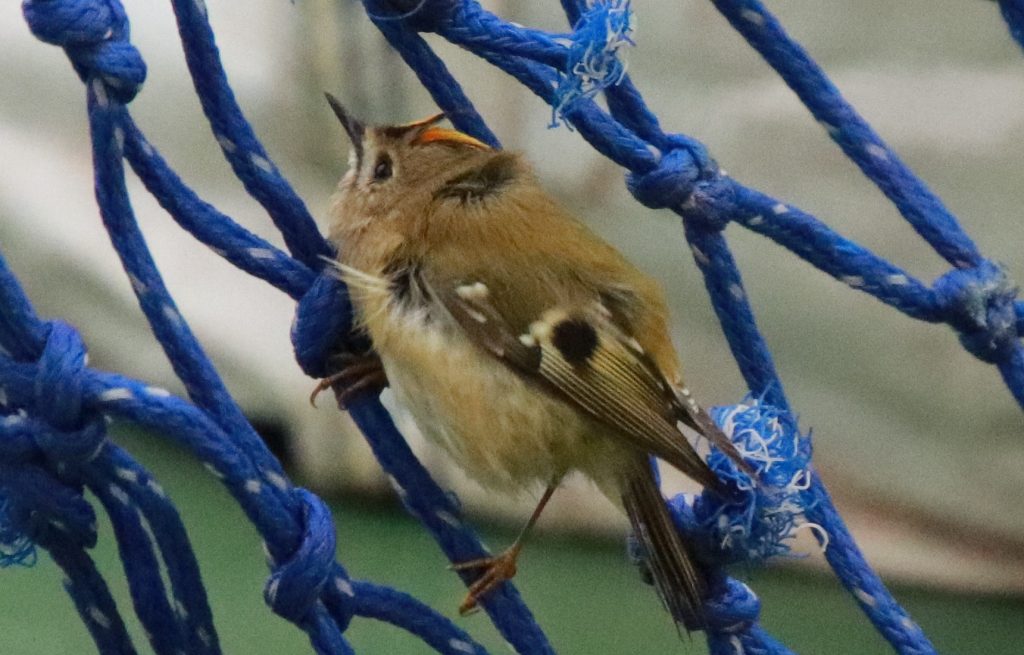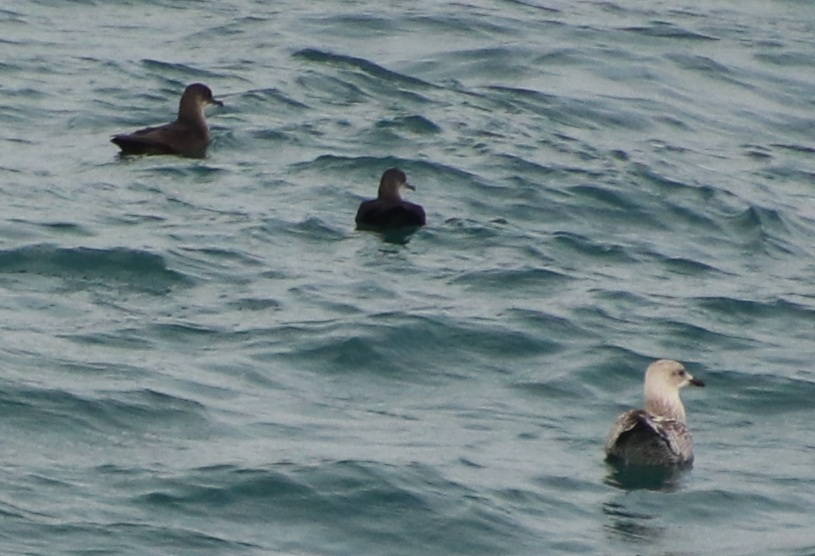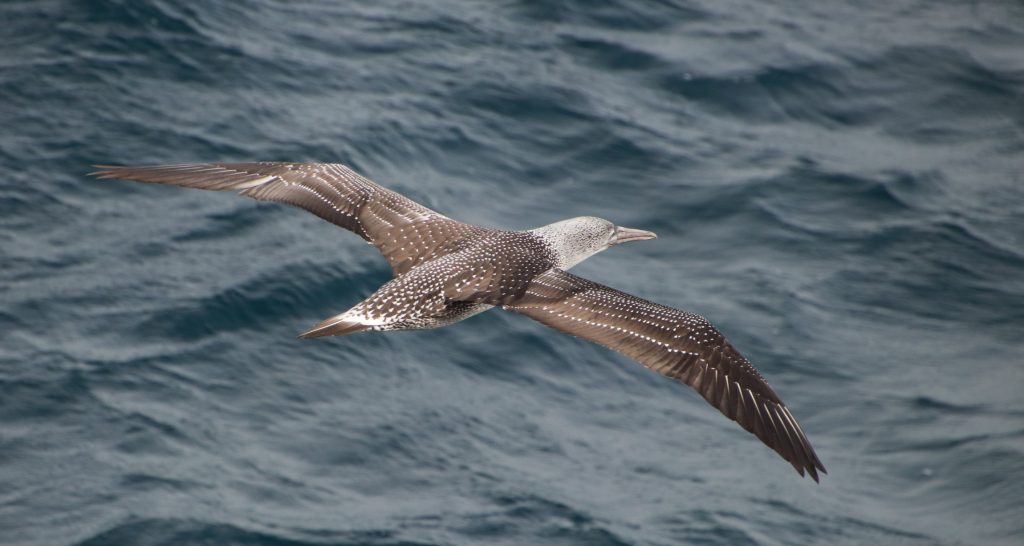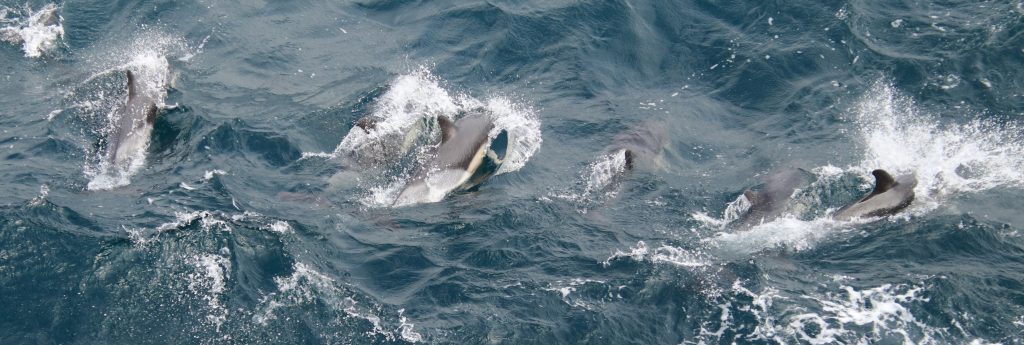 PELTIC 2025 – 11-12 October
PELTIC 2025 – 11-12 October
12 October 2025
11th
The conditions today were very similar to those we had left the night before, namely, overcast with a flat sea and challenging light conditions. We were back at the place we had left off on Transect 35 knowing they may go fishing any time at all.
In the first hour we mainly saw Gannet and a variety of gulls. The group of Goldfinch were still with the ship as well as the Chiffchaff. Overnight we had also gained a Robin which had been seen taking a tour of the inside space on the ship, much to the amusement of the fisheries scientists.
Only a couple of pods of Common Dolphin came into the ship before we broke off to trawl around 08:00. There must have been a lot of fish seen on the trawl sonar as we only trawled for half the normal time but still came up with a good catch of mainly Sardine and Spratt. During the trawl a Goldcrest was spotted fluttering around a net on the upper deck.

We were back on transect by about 09:30 and shortly after we came across a large group of feeding Gannet with splashes from tuna feeding. As we headed north towards the coast the number of Razorbill and Guillemot started to pick up, and we had another couple more sightings of Balearic Shearwater.
Three more small pods of Common Dolphin were also seen coming into the ship before we reached the end of the transect just before 11:00. With 16 miles to go before the next transect it meant we could get lunch in before we were back on watch.
During the steam to Transect 33 we spotted a couple more Balearic Shearwater resting on the water with some gulls, so we were hopeful for more as we started the transect. We did see a couple more Balearic Shearwaters later on in the transect but the birds were dominated by Gannet and gulls. A single Fulmar was seen adding to our low count of them.

Common Dolphin appeared regularly throughout the transect, by the time we had finished there had been 13 separate encounters involving 85 animals.
With a couple of hours to go we worked out that the transect would finish and we would have time before the next transect to get our dinner (dinner being served at 16:45 on here). Then it was decided we would do a trawl which meant dinner would be just after we restarted, I should have known better. Luckily for us the second officer said, “You can’t do that, there’s a fishing boat already fishing exactly where you want to trawl”. So, the idea was abandoned, the lead scientist saying “I’ll be back” as he left the bridge, and we carried on till the end of the transect. All this meant we got to have a relaxed dinner.
Due to the poor light, it was decided not to head for the next transect but do a trawl instead, so an early finish for us observers. It may have been an easy evening for us but for the scientists, with an 18:30 trawl, processing what’s caught and doing a number of the static stations it’s going to be a hard day’s night.
So, what did we learn today:
• Don’t make your dinner plans too early
• Fishing boats stop trawls
• Passerine accommodation on the Endeavour must be excellent
12th
We are being spoilt, we had a flat sea again this morning! There was however a bit of mist but nothing too bad. The trawl the previous evening had gone well with another short trawl of 15 minutes producing mainly Anchovy and a smattering of other species.
We started on Transect 32 at 07:30 with a posse of gulls around the ship, lured in by the smell of fish. This quickly turned into Gannet only, with most of them being adults, which is in contrast to the previous days where there was a large proportion of younger birds particularly juvenile and second year. So, Transect 32 must be for the old timers. A few Storm Petrel were spotted mid-morning with a raft of about 40 just off the ship.

Small pods of Common Dolphin came in regularly throughout the morning with 10 encounters and a total of 37 animals. The transect was due to finish at 11:45 so around 10:00 Phil and I decided we weren’t going to trawl, and each took a short break for a drink and a rest. Yes, you guessed it, just after that at about 10:20 it was decided to pull off and have a trawl – it’s all too much.
During the trawl there were about 20 Common Dolphin splashing about 400 metres off the stern of the ship about where the net would have been under the water, perhaps they were picking up bits of fish that were being washed out of the net below.
Before the net was recovered there were just a handful of birds around the ship. When we started hauling the net the Gannet started to assemble as well as the Common Dolphin. All together now they started feeding, they were going to wait for no one. Ultimately there were over 100 Gannet diving in around the net along with a large number of dolphin around the net. They obviously knew it was a good catch, as it turned out to be mainly of Sardine and Anchovy.

After the trawl we had just over an hour till the end of the transect but recorded only a few birds. We then had about 10 minutes before we were onto Transect 50 and heading towards France.
For most of this transect it proved to be a Gannet count, there were Gannet here, there and everywhere. The dominance of the adult Gannet continued as it had in the previous transect. There was a short interlude where a couple of Storm Petrel, a Great Skua and a single Balearic Shearwater where seen, just to mix things up a little. We also saw a few new species for the trip. A single Grey Heron flew past close to the ship, a Puffin was seen flapping off across the surface to the port side, and also a single Cormorant passed by.
We completed the transect as it had started, counting Gannet until the end at 18:00. The ship then headed off for another trawl, and we all hoped for a good day with sunshine tomorrow.
So, what have we learnt today:
• Transects 32 & 50 are for the more mature Gannet
• If you want the scientists to trawl, take a break

